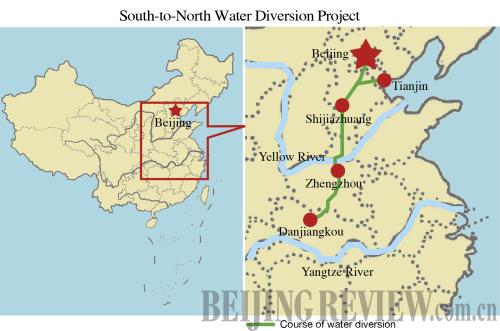|
He said the sharp increase in new enterprises in Beijing had greatly contributed to the population explosion. The professor believes the key is to set up a standard to limit the establishment of new companies in the capital.
Hou said many companies were attracted to Beijing as it is seen as offering many opportunities, but the lower access thresholds had led to the city's population to rise too quickly.
Ongoing endeavors
During the past five years, Beijing has invested more than 4 billion yuan ($608 million) in the conservation of water resources and construction of water supply projects. Facing up the water shortage plague, the city has worked out and implemented various countermeasures, such as developing water-efficient agriculture and industry, to decrease the annual water consumption from 4 billion cubic meters in 2001 to 3.46 billion cubic meters in 2009.
But the even drier weather in Beijing over the past decade, shrinking stock of local reservoirs and declining groundwater levels highlight the importance of finding new water sources.
In a bid to relieve Beijing's water shortage, 200 million cubic meters of water was transferred from three reservoirs in Beijing's neighboring Hebei Province to the metropolis from May to November in 2010.
That was the second large-scale water transfer for the Beijing-Shijiazhuang section in the middle route of the South-to-North Water Diversion Project since its construction in 2008. The project basically will divert water from the south Yangtze River to the Yellow River and Haihe River in the north.
From September 18, 2008 to July 25, 2009, four reservoirs in Hebei transferred a total of 435 million cubic meters of water to Beijing. The transfer was carried out at a time when the South-to-North Water Diversion Project was postponed for five years.
In the meantime, Beijing has taken water conservation and utilization to an advanced level. This winter, two vehicles with high-powered heaters capable of processing around 100 cubic meters of snow and ice an hour will be sent to locations around the Tiananmen Square when snow occurs. Clean snow will also be dumped into dammed sections in three rivers that drift through the city to be used for road cleaning, irrigation and to supplement the rivers' water levels.
To conserve water and reduce waste, Beijing had raised water prices several times. The latest price hike came in December 2009, with a margin of 24 percent. The price of water for residential use rose from 3.7 yuan ($0.54) to 4.6 yuan ($0.67). The government offered subsidies to low-income families to ensure their living standard would not be affected by the hike.
Beijing will adopt tough water management measures in the next five years to ease acute water shortages, according to local water authorities.
The measures include setting warning lines for the amount of water consumption, efficiency of water use and water pollution levels within the metropolitan area, Bi Xiaogang, spokesman for the Beijing Water Authority, told Beijing Today, a local English weekly paper.
Local governments would suffer punishment if they fail to meet the targets, he said. This is the first time such measures had been formulated.
The measures, still being drafted by the municipal government, will be implemented during the first half of 2011, Bi said.
Droughts Continue
Around 2.2 million people are facing a shortage of drinking water due to a severe drought in parts of central, south and east China, with cities starting to run low on supplies.
Rainfall is down by between 20 to 90 percent compared with the same period last year in the provinces of Henan, Shanxi, Hebei, Shandong, Jiangsu, Anhui and Shaanxi.
Continuing droughts started to dry out winter wheat producing areas such as Shandong and Henan provinces last November, affecting some 4 million hectares of cropland.
The dry weather has affected winter wheat crops in 17 percent of China's wheat growing areas in the country's northern breadbasket, and such weather is forecast to extend until spring of 2011.
(Source: Xinhua News Agency)

| 